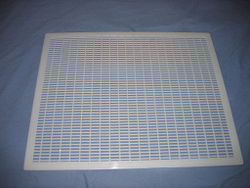Queen excluder
This article has multiple issues. Please help improve it or discuss these issues on the talk page. (Learn how and when to remove these template messages)
|
 A queen excluder | |
| Classification | Beekeeping |
|---|---|
| Used with | Langstroth hive |
| Inventor | Petro Prokopovych |
| Manufacturer | various |
In beekeeping, a queen excluder is a selective barrier inside the beehive that allows worker bees but not the larger queens and drones to traverse the barrier. The bars have a distance of 4.2 millimeters. The barrier grid was probably invented around 1890.
The purpose is to prevent the queen from moving from the brood chamber to the honey chamber. There she would lay her eggs between storage cells with honey, so that bee larvae or eggs would get into the honey during centrifuging.
Queen excluders are also used with some queen breeding methods.
Design[edit]

Typically, the queen excluder is either a sheet of perforated metal or plastic or a wire grid in a frame with openings are limited to 0.163 inches (4.1 mm). Queen excluders can also be constructed of hardware cloth screen, of which #5 hardware cloth is often cited in references as sufficient for allowing worker bees to pass, but not queens.
Purpose[edit]

The intent of the queen excluder is to limit the queen's access to the honey supers. If the queen lays eggs in the honey supers and a brood develops in them it is difficult to harvest clean honey. It makes fall management more difficult. Queen excluders are removed in the autumn; otherwise, the queen would not be able to move with the winter cluster and would die from exposure. A replacement queen can be difficult to introduce because the bees will not be accustomed to the new queen's pheromones. New queens can be killed by the hive. Therefore, the death of a queen in winter is dangerous for a hive and can be expensive for a beekeeper.
Queen excluders are used with some queen breeding methods, especially as a way to allow queen cells to be built in the same hive with an existing queen, or as a way to house multiple queens in the same hive.[1][page needed]
Reception[edit]

Some beekeepers[who?] who oppose the use of queen excluders claim that excluders lead to less efficient hives as the worker bees, which are not used to flying through the eliminator, are intimidated and stay in the lower brood box. This leads to rapid filling of the brood box and overcrowding, which eventually leads to swarming of the hive. Professional beekeepers, who have been using queen eliminators as an essential part of their beekeeping method for a century, report otherwise.
References[edit]
- ^ Doolittle, G.M. (1889). Scientific Queen-rearing as Practically Applied; Being a Method by which the Best of Queen-Bees are Reared in Perfect Accord with Nature's Ways. Chicago: Thomas G. Newman & Son.
